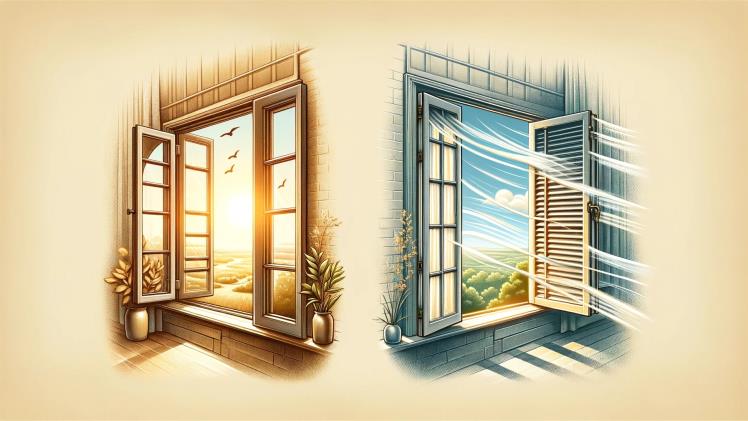Casement windows and sash windows offer different approaches to ventilation, each with its own advantages.
Casement windows provide effective and versatile ventilation by fully opening outward, allowing unrestricted airflow and catching breezes from various angles, making them suitable for cross-ventilation.
On the other hand, sash windows, particularly double-hung ones, allow controlled ventilation through sliding sashes.
Casement Windows:
- Advantages: Better ventilation, unobstructed views, energy efficiency, modern aesthetics.
- Considerations: Wind resistance, limited window covering options, cleaning challenges.
Sash Windows:
- Characteristics: Traditional and timeless aesthetic, common in historical homes.
- Energy Efficiency: Sash windows can be equipped with double-glazing and weatherstripping for improved insulation in colder climates.
- Ventilation: While they may not fully open like casement windows, their dual sashes enable adjustable top and bottom openings for regulating airflow.
In terms of ventilation, casement windows excel in maximizing airflow and cross-ventilation due to their outward opening design.
On the other hand, sash windows provide adjustable and balanced airflow options through sliding sashes.
The choice between these window types ultimately depends on architectural style, design preferences, and functional requirements such as ventilation, light intake, and energy efficiency.
Advantages of Casement Windows Over Sash Windows
Casement windows offer several advantages over sash windows, making them a popular choice for many homeowners:
- Energy Efficiency: Casement windows are known for their tight seal when closed, enhancing energy efficiency by minimizing air leakage and heat loss.
- Ease of Operation: Taller casement windows are easier to open and close compared to sash windows, especially for individuals who may find reaching upward challenging.
- Unobstructed Views: Casement windows provide larger glass panels, offering an unobstructed view outside and allowing maximum light into the home.
- Ventilation: Casement windows can fully open outward, maximizing airflow and enabling cross-ventilation, which is beneficial for air circulation and freshness in the home.
- Modern Aesthetics: Casement windows often align well with contemporary or modern architectural styles, providing a sleek and minimalist look that complements newer builds.
In summary, the advantages of casement windows include superior energy efficiency, ease of operation, unobstructed views, effective ventilation, and a modern aesthetic appeal compared to sash windows.
Maintenance Requirements for Casement Windows Compared to Sash Windows
When comparing the maintenance needs of casement windows and sash windows, several factors come into play:
Casement Windows:
- Cleaning: Casement windows are easier to clean due to their design that allows full access to both sides of the glass panes, simplifying the cleaning process.
- Weatherproofing: The tight closure of casement windows provides superior insulation against drafts and air leaks, contributing to their longevity and energy efficiency.
- Security: Casement windows often feature multi-point locks that securely anchor them into the frame when closed, enhancing security.
Sash Windows:
- Cleaning: Sash windows can be more challenging to clean compared to casement windows, especially in cases where only one sash is movable. However, modern double-hung sash windows can tilt inwards for easier cleaning from inside the home.
- Weatherproofing: While sash windows are more prone to infiltration, modern enhancements like weatherstripping can improve their thermal performance and weatherproofing capabilities.
- Security: Sash windows can be secure with high-quality locks and toughened glass or double glazing, ensuring adequate security measures are in place.
In summary, casement windows generally require less maintenance than sash windows due to easier cleaning access and superior weatherproofing. However, both window types can be energy-efficient and secure with proper maintenance and upkeep.

